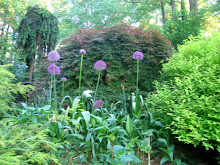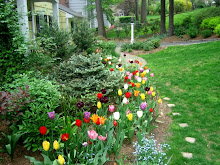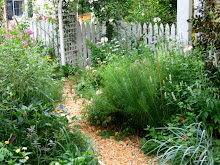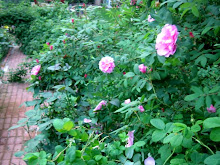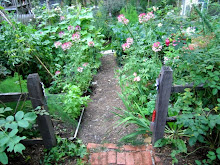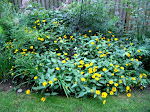
Welcome to Heirloom Gardener
Wednesday, August 20, 2008
Heirloom Pairing for Heirloom Roses: Picture of a Pretty Pink Perennial Sweet Pea in the Cutting Garden
Posted by
Julia Erickson
at
9:12 PM
3
comments
![]()
![]()
Labels: Annuals/Biennials and Perennials, Roses, Summer Garden
Thursday, August 14, 2008
Garden Bloggers' Bloom Day August 2008 - My Collection of Fragrant Phlox
In anticipation of Garden Bloggers' Bloom Day on May Dreams Gardens tomorrow, here are some of the phlox that have been blooming throughout my garden over the last few weeks. Most are heirloom, some are new, and almost all of them are fragrant.
Posted by
Julia Erickson
at
9:18 PM
10
comments
![]()
![]()
Labels: Annuals/Biennials and Perennials, Garden Bloggers' Bloom Day
Friday, August 08, 2008
Two New Summer Favorites: Double Tiger Lily and Excelsior Lily
My two favorite new lilies this year were the double tiger lily and the Excelsior lily both from Old House Gardens.
 The double tiger lily bloomed over a four week period in part shade. The flowers are definitely interesting and far more attractive than the catalog picture is able to capture.
The double tiger lily bloomed over a four week period in part shade. The flowers are definitely interesting and far more attractive than the catalog picture is able to capture. Since tiger lilies rapidly reproduce from the small bulblets that form along the stem, I am hoping that they will take over the open space next to the fort in the Walled Garden.
Since tiger lilies rapidly reproduce from the small bulblets that form along the stem, I am hoping that they will take over the open space next to the fort in the Walled Garden. For fragrance, the Excelsior lily is phenomenal. The fragrance is rich and unlike any of the other lilies I grow. In addition, they came at a time when my other lilies were finished except for yet to bloom Rubrum Lily.
For fragrance, the Excelsior lily is phenomenal. The fragrance is rich and unlike any of the other lilies I grow. In addition, they came at a time when my other lilies were finished except for yet to bloom Rubrum Lily. The colors are a beautiful and vibrant mix of yellow, cream, and peach. I will be ordering more of these for my cutting garden next year.
The colors are a beautiful and vibrant mix of yellow, cream, and peach. I will be ordering more of these for my cutting garden next year.
Posted by
Julia Erickson
at
9:34 PM
4
comments
![]()
![]()
Labels: Lilies, Summer Garden
Thursday, August 07, 2008
Gardening Blogs are Growing in Chatham, New Jersey
I'm pleased to announce that there are two new gardening blogs from fellow gardeners in Chatham, New Jersey:
Marta McDowell, "a blog about digging in the dirt, growing flowers and vegetables, garden history, horticulture and nature."
Visual Thinking in a Fairmount Garden, "A textile designer among the weeds of her mind."
Posted by
Julia Erickson
at
7:54 AM
4
comments
![]()
![]()
Wednesday, August 06, 2008
Covered Containers for Propagation: GardenTalk.com's Bell Boys

They are from Walt Nicke's GardenTalk: A Catalog of Fine Tools for Gardeners. You can find them under the section Potting and Propagators under the name Bell Boys. They come in two sizes in packages of six.
You can use them to propagate cuttings of other plants too, not just hydrangeas. In fact, I am also propagating the rose Frau Dagmar Harstropp, in another set of these containers just now.
Posted by
Julia Erickson
at
10:58 PM
1 comments
![]()
![]()
Labels: Gardening Tools and Structures, Propagation and Seeds
Nan Ondra, Garden Writer/Blogger, Featured in The New York Times
Nan Ondra, one of my favorite garden bloggers, the genius behind both Gardening Gone Wild (a blogging consortium and host of the Garden Bloggers' Design Workshop) and Hayefield (her personal blog), was featured in last week's New York Times. In the article, "Where Foliage Eclipses Flowers," journalist Anne Raver talks with Nan about her life, her garden, and her books (Nan just published her twelfth).
Posted by
Julia Erickson
at
7:56 AM
0
comments
![]()
![]()
Labels: Gardening Blogs
Tuesday, August 05, 2008
Caterpillars that Sting: Pictures of Saddleback Caterpillars (Acharia stimulea)

Posted by
Julia Erickson
at
11:19 PM
3
comments
![]()
![]()
Labels: Wildlife in the Garden
"Children have lost touch with the natural world and are unable to identify common animals and plants," according to a UK survey
As a follow-up to my prior post on Richard Louv's book, Last Child in the Woods - Saving Our Children from Nature Deficit Disorder, the UK newspaker, The Independent, ran an article about a UK survey on the subject. Sadly, the journalist Sarah Cassidy reports:
"Half of youngsters aged nine to 11 were unable to identify a daddy-long-legs, oak tree...or bluebell, in the poll by BBC Wildlife Magazine. The study also found that playing in the countryside was children's least popular way of spending their spare time, and that they would rather see friends or play on their computer than go for a walk or play outdoors."
"Experts blamed the widening gulf between children and nature on over-protective parents and the hostility to children among some conservationists, who fear that they will damage the environment. They said that this lack of exposure to outdoor play in natural environments was vital for children's social and emotional development."
"Dr Martin Maudsley, play development officer for Playwork Partnerships, at the University of Gloucestershire, said that adults had become too protective of wild places: 'Environmental sensitivities should not be prioritised over children.'"
"He said: 'Play is the primary mechanism through which children engage and connect with the world, and natural environments are particularly attractive, inspiring and satisfying for kids. Something magical occurs when children and wild spaces mix.'"
Posted by
Julia Erickson
at
7:06 AM
6
comments
![]()
![]()
Labels: Deep Thoughts About Gardening, Gardening with Children
Sunday, August 03, 2008
Picture of an Eastern Tiger Swallowtail (Pterourus glaucus) on a Butteryfly Bush (Buddleia)
Posted by
Julia Erickson
at
10:00 PM
0
comments
![]()
![]()
Labels: Wildlife in the Garden
Saturday, August 02, 2008
More Pictures of This Year's Beautiful Hydrangeas
I'm really enjoying the hydrangeas in my garden this year. Hydrangeas are great because they take so little work and get better year after year. The blooms on hydrangeas are fascinating to watch as their colors mature and change as the blooms age. Below are some pictures of some of the hydrangea in my garden that were not in my Garden Bloggers' Bloom Day post for July.



Posted by
Julia Erickson
at
11:03 AM
5
comments
![]()
![]()
Labels: Cut and Forced Flowers, Hydrangeas, Summer Garden
Friday, August 01, 2008
How to Propagate Hydrangea, Part II: Layering Marechal Foch

 As you see in the close up of the mature specimen, the leaves are thick and shiny. The mopheads change a lot over the course of the summer. Two weeks ago, in the the last picture on my Garden Bloggers' Bloom Day post, the blooms were various shades of pink.
As you see in the close up of the mature specimen, the leaves are thick and shiny. The mopheads change a lot over the course of the summer. Two weeks ago, in the the last picture on my Garden Bloggers' Bloom Day post, the blooms were various shades of pink. The third picture is the baby of Marechal Foch in the Front Border which I propagated last year by layering my mother plant.
The third picture is the baby of Marechal Foch in the Front Border which I propagated last year by layering my mother plant.
Posted by
Julia Erickson
at
11:08 PM
1 comments
![]()
![]()
Labels: Front Border, Hydrangeas, Propagation and Seeds
Search Heirloom Gardener
Labels
- About Blogging
- Annuals/Biennials and Perennials
- Autumn Garden
- Books and Movies
- Botanical Gardens
- Bulbs and Tubers
- Children's Garden
- Chrysanthemum
- Clematis
- Container Gardening
- Crocus tommasiniasus roseus
- Cut and Forced Flowers
- Cutting and Rose Gardens
- Dahlias
- Deep Thoughts About Gardening
- Egg Garden
- Fences Arbors Walls and Paths
- Floral arrangements
- Front Border
- Fun Stories About Gardening
- Garden Bloggers' Bloom Day
- Garden Bloggers' Design Workshop
- Garden Planning
- Gardening Blogs
- Gardening Tools and Structures
- Gardening with Children
- Goldberry Hill
- Heirloom and Organic Food
- Hibiscus
- Holidays
- Hydrangeas
- Japanese Beautyberry
- Lilies
- Mixed Borders
- New Jersey / Local Interest
- Nurseries
- Online Gardening Resources
- Peonies
- Pest Control
- Picture This Photo Contest
- Piet Oudolf
- Poppies
- Propagation and Seeds
- Pruning and Maintenance
- Roses
- Seed Heads
- Self Seeders
- Shrubs
- Spring Garden
- Summer Garden
- Trees
- Wildlife in the Garden
- Winter Garden
- Zinia
Blog Archive
-
▼
2008
(202)
-
▼
August
(11)
- Heirloom Pairing for Heirloom Roses: Picture of a...
- Garden Bloggers' Bloom Day August 2008 - My Collec...
- Two New Summer Favorites: Double Tiger Lily and E...
- Gardening Blogs are Growing in Chatham, New Jersey
- Covered Containers for Propagation: GardenTalk.co...
- Nan Ondra, Garden Writer/Blogger, Featured in The ...
- Caterpillars that Sting: Pictures of Saddleback C...
- "Children have lost touch with the natural world a...
- Picture of an Eastern Tiger Swallowtail (Pterourus...
- More Pictures of This Year's Beautiful Hydrangeas
- How to Propagate Hydrangea, Part II: Layering Mar...
-
▼
August
(11)































